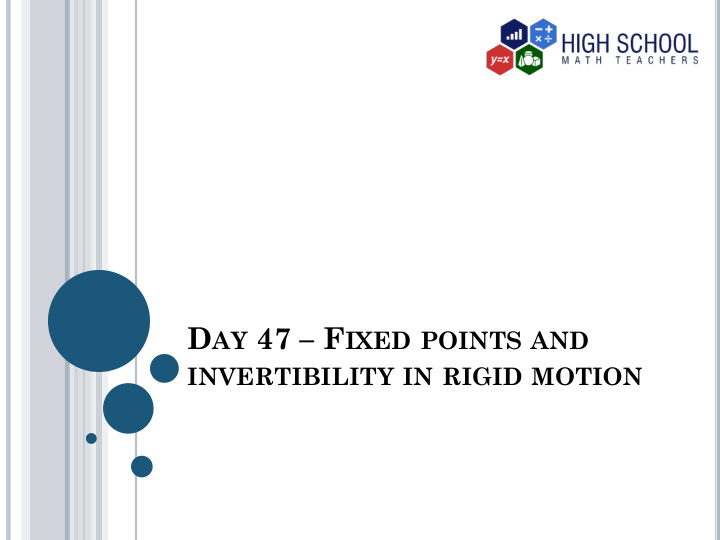



D AY 47 – F IXED POINTS AND INVERTIBILITY IN RIGID MOTION
I NTRODUCTION When a figure is rotated, translated, reflected or undergoes a glide reflection number of things may or may not change. Like in many rotations and reflections, the orientation of the pre-image changes. One the other hand, there are other features that do not change, it is known that the length, angle hence the shape does not change. Further, when the object undergoes the above transformations, we understand that we can get another transformation that can map the image back to the pre-image.
In this lesson, we are interested in yet another feature that does not change in rotation and reflection. We will also discuss cases where the transformation can be reversed to get back the pre- image. We will not prove these theorems but we will just explain what they mean an illustrate the results.
V OCABULARY Fixed point This refers to a point that does not change after any transformation or function. If f is the function and 𝑦 is a fixed point, then 𝑔 𝑦 = 𝑦 Similar, if 𝑈 is a transformation when it acts on 𝑦, we still get 𝑦 , that is 𝑈𝑦 = 𝑦. Invertible transformation A transformation is invertible if, given the image, we can apply another transformation to get the original pre-image.
We will proceed to discuss the theorems in this lesson. Theorem Any plane rigid motion is invertible Explanation This is true when a rigid motion is applied on a figure, we can apply another rigid motion to transform the image back to the pre-image.
We a figure is rotated about a point through an angle of 𝜄° , we can reverse this by rotating the image at an angle −𝜄°. When a figure is translated through a vector 𝑏, 𝑐 = 𝑏 𝑐 , to get (𝑦 + 𝑏, 𝑧 + 𝑐) ,we apply a translation of the negative vector, − 𝑏 𝑐 , to get the pre-image, 𝑦 + 𝑏 − 𝑏, 𝑧 + 𝑐 − 𝑐 = 𝑦, 𝑧 . When a figure is reflected about a line to get an image, we apply a reverse reflection of the image about the same line to get the pre-image.
Example 1 The image of a point after a glide reflection about the y-axis and translation of 3 units in the positive x-direction and 1 downwards is (2, −5) . Find the original pre-image. Solution We first carry out the reverse reflection. The translation is 𝑦 − and 𝑧 − direction is 𝑈 = (3, −2) , thus, the reverse is −𝑈 = (−3,2) . Thus, the image after reverse translation is 2, −5 + −3,2 = (−1, −3) .
Next we carry out opposite reflection about the y axis. Reflection of a point (𝑦, 𝑧) about 𝑧 − axis is (−𝑦, 𝑧) Thus, −𝑦, 𝑧 = (−1, −3) . The original point is 𝑦, 𝑧 = (1, −3)
Theorem Any rigid motion with a fixed point is either a reflection or a rotation Explanation A fixed point is a point on the pre-image that does not change when an object undergoes a rigid motion. Since in translation, all points move through the sane distance, it has no fixed point.
Fixed points in the rotation In rotation, only the center of rotation is the one that does not move. Thus, the fixed point in the rotation is the point on the pre-image that is at the center of rotation. In special cases, the fixed points may be all the points on the pre-image. This is the case when the figure is rotated about any point through an angle that is a multiple of ±360°.
Fixed points of reflection When a figure is reflected once, all points on the pre-image moves except the those at the line of reflection. Hence when the mirror line passes through the pre-image or is part of the sides of the pre-image, they are only those points of the pre- image on the mirror line that are fixed hence do not move. Example 2 Find the fixed points of the line reflected about its perpendicular bisector.
Solution The intersection of the mirror line and the pre- image is one point at the intersection of the line at its perpendicular bisector, hence, it is the fixed point.
HOMEWORK Find the fixed point of a rotation of closed circle of center at (0,0) and radius 2 if translated through 1 unit.
A NSWERS TO HOMEWORK All points moves by one unit, hence, there is no fixed point.
END
Recommend
More recommend